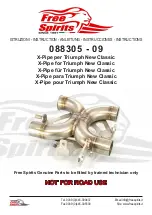
21
HONDA O/M ’04 CR125R (E) (AH) 31KSR600
1
2
2
2. Add coolant up to the filler neck if the level is low.
NOTE:
•
Inspect the coolant level before each outing. A
coolant loss of 0.7—2.0 US oz (20—60 cm
3
, 0.7—2.1
lmp, oz) through the over flow tube is normal. If
coolant loss is more than this, inspect the cooling
system.
Capacity: 1.03 US qt (0.97 liter, 0.85 lmp qt)
at disassembly
0.93 US qt (0.88 liter, 0.77 lmp qt)
at coolant change
3. Install the radiator cap securely.
CAUTION:
•
If the radiator cap is not installed properly, it will
cause excessive coolant loss and may result in
overheating and engine damage.
Cooling System Inspection
1. Check the cooling system for leaks (see the Honda
Service Manual for troubleshooting of leaks).
2. Check water hoses for cracks, deterioration, and
clamp bands for looseness.
3. Check the radiator mount for looseness.
4. Make sure the overflow tube is connected and not
clogged.
5. Check the radiator fins for clogging.
6. Check the water leakage check hole below the
water pump for leakage. Make sure the hole remains
open. If water leaks through the check hole, the
water pump seal is damaged. If oil leaks through the
check hole, the transmission oil seal is damaged.
See the Honda Service Manual or consult your
authorized Honda dealer for replacing the water
pump seal or the transmission oil seal. Both seals
should be replaced at the same time.
COOLANT
Coolant Recommendation
Use Pro Honda HP coolant or an equivalent high quality
ethylene glycol based anti-freeze containing corrosion
protection inhibitors specifically recommended for use
in aluminum engines (See anti-freeze container label).
CAUTION:
•
Hard water or salt water is harmful to aluminum.
The factory provides a 50/50 mix of anti-freeze and
water in your CR. This mixture is recommended for
most operating temperatures and provides good
corrosion protection. A higher concentration of anti-
freeze decreases the cooling system performance
and is recommended only when additional protec-
tion against freezing is needed. Using less than 40%
anti-freeze will not provide proper cooling or corro-
sion protection.
•
Using coolant with silicate inhibitors may cause
premature wear of water pump seals or blockage
of radiator passages. Using tap water may cause
engine damage.
Coolant Level
•
Never remove the radiator cap when the engine is
hot. The coolant is under pressure and severe
scalding could result.
1. With the engine cold, remove the radiator cap and
check coolant level. The coolant level is correct
when it is at the bottom of the radiator filler neck.
(1) RADIATOR CAP
(1) OVERFLOW TUBE
(2) WATER HOSE
(3) WATER PUMP COVER
(4) WATER LEAKAGE CHECK HOLE
*CR125R (E) P011-023
12/10/03, 2:50 PM
21





























